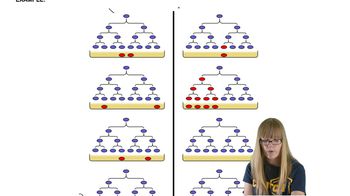What is the difference between biochemical and biological function?
Table of contents
- 1. Introduction to Genetics51m
- 2. Mendel's Laws of Inheritance3h 37m
- 3. Extensions to Mendelian Inheritance2h 41m
- 4. Genetic Mapping and Linkage2h 28m
- 5. Genetics of Bacteria and Viruses1h 21m
- 6. Chromosomal Variation1h 48m
- 7. DNA and Chromosome Structure56m
- 8. DNA Replication1h 10m
- 9. Mitosis and Meiosis1h 34m
- 10. Transcription1h 0m
- 11. Translation58m
- 12. Gene Regulation in Prokaryotes1h 19m
- 13. Gene Regulation in Eukaryotes44m
- 14. Genetic Control of Development44m
- 15. Genomes and Genomics1h 50m
- 16. Transposable Elements47m
- 17. Mutation, Repair, and Recombination1h 6m
- 18. Molecular Genetic Tools19m
- 19. Cancer Genetics29m
- 20. Quantitative Genetics1h 26m
- 21. Population Genetics50m
- 22. Evolutionary Genetics29m
15. Genomes and Genomics
Functional Genomics
Problem 30
Textbook Question
Hereditary spherocytosis (HS) is a disorder characterized by sphere-shaped red blood cells, anemia, and other abnormal traits. Ankyrin-1 (ANK1) is a protein that links membrane proteins to the cytoskeleton. Loss of this activity is associated biochemically to HS. However, Gallagher et al. (2010) (J. Clin. Invest. 120:4453–4465) show that HS can also be caused by mutations within a region from -282 to -101 relative to the transcriptional start site, which lead to constitutive transcriptional repression in erythroid cells due to local chromatin condensation. Propose a hypothesis for the function of the -282 to -101 region of the ANK1 gene.
 Verified step by step guidance
Verified step by step guidance1
Understand the context: The region from -282 to -101 relative to the transcriptional start site is upstream of the ANK1 gene, indicating it is part of the gene's promoter or regulatory region.
Recall that promoter regions contain specific DNA sequences where transcription factors and other regulatory proteins bind to control gene expression, either activating or repressing transcription.
Given that mutations in this region cause constitutive transcriptional repression and chromatin condensation, hypothesize that this region normally functions as a binding site for transcriptional activators or chromatin remodelers that maintain an open chromatin state to allow ANK1 expression in erythroid cells.
Consider that loss of function mutations here might disrupt binding of these activators or recruit repressors, leading to chromatin condensation and reduced transcription of ANK1, which contributes to the HS phenotype.
Therefore, propose that the -282 to -101 region acts as a positive regulatory element (such as an enhancer or promoter element) necessary for proper transcriptional activation of ANK1 in erythroid cells.
 Verified video answer for a similar problem:
Verified video answer for a similar problem:This video solution was recommended by our tutors as helpful for the problem above
Video duration:
1mPlay a video:
Was this helpful?
Key Concepts
Here are the essential concepts you must grasp in order to answer the question correctly.
Gene Promoter and Regulatory Regions
Promoter regions are DNA sequences located upstream of a gene's transcription start site that regulate gene expression. They contain binding sites for transcription factors and other proteins that either activate or repress transcription. The region from -282 to -101 likely functions as a regulatory element influencing ANK1 gene expression in erythroid cells.
Recommended video:
Guided course

Mapping Genes
Chromatin Structure and Transcriptional Regulation
Chromatin condensation affects gene accessibility by controlling how tightly DNA is packed. When chromatin is condensed, transcription factors cannot access DNA, leading to transcriptional repression. Mutations causing local chromatin condensation in the ANK1 regulatory region can reduce gene expression, contributing to hereditary spherocytosis.
Recommended video:
Guided course

Chromatin
Role of Ankyrin-1 in Red Blood Cells and Disease Mechanism
Ankyrin-1 links membrane proteins to the cytoskeleton, maintaining red blood cell shape and stability. Loss of Ankyrin-1 function disrupts membrane integrity, causing sphere-shaped cells and anemia in HS. Mutations affecting ANK1 expression or function can thus lead to the disease phenotype.
Recommended video:
Guided course

Spontaneous Mutations
Related Videos
Related Practice
Textbook Question
728
views


